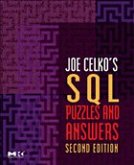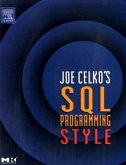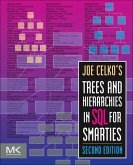Joe Celko
Joe Celko's Thinking in Sets: Auxiliary, Temporal, and Virtual Tables in SQL
Joe Celko
Joe Celko's Thinking in Sets: Auxiliary, Temporal, and Virtual Tables in SQL
- Broschiertes Buch
- Merkliste
- Auf die Merkliste
- Bewerten Bewerten
- Teilen
- Produkt teilen
- Produkterinnerung
- Produkterinnerung
Perfectly intelligent programmers often struggle when forced to work with SQL. Why? Joe Celko believes the problem lies with their procedural programming mindset, which keeps them from taking full advantage of the power of declarative languages. The result is overly complex and inefficient code, not to mention lost productivity.This book will change the way you think about the problems you solve with SQL programs.. Focusing on three key table-based techniques, Celko reveals their power through detailed examples and clear explanations. As you master these techniques, you'll find you are able to…mehr
Andere Kunden interessierten sich auch für
![Joe Celko's SQL Puzzles and Answers Joe Celko's SQL Puzzles and Answers]() Joe CelkoJoe Celko's SQL Puzzles and Answers47,99 €
Joe CelkoJoe Celko's SQL Puzzles and Answers47,99 €![Joe Celko's SQL Programming Style Joe Celko's SQL Programming Style]() Joe CelkoJoe Celko's SQL Programming Style32,99 €
Joe CelkoJoe Celko's SQL Programming Style32,99 €![Joe Celko's Trees and Hierarchies in SQL for Smarties Joe Celko's Trees and Hierarchies in SQL for Smarties]() Joe CelkoJoe Celko's Trees and Hierarchies in SQL for Smarties27,99 €
Joe CelkoJoe Celko's Trees and Hierarchies in SQL for Smarties27,99 €![Joe Celko's Data, Measurements and Standards in SQL Joe Celko's Data, Measurements and Standards in SQL]() Joe CelkoJoe Celko's Data, Measurements and Standards in SQL39,99 €
Joe CelkoJoe Celko's Data, Measurements and Standards in SQL39,99 €![Joe Celko's Complete Guide to NoSQL Joe Celko's Complete Guide to NoSQL]() Joe CelkoJoe Celko's Complete Guide to NoSQL31,99 €
Joe CelkoJoe Celko's Complete Guide to NoSQL31,99 €![SQL Clearly Explained SQL Clearly Explained]() Jan L. HarringtonSQL Clearly Explained42,99 €
Jan L. HarringtonSQL Clearly Explained42,99 €![SQL SQL]() Michael J. DonahooSQL26,99 €
Michael J. DonahooSQL26,99 €-
-
-
Perfectly intelligent programmers often struggle when forced to work with SQL. Why? Joe Celko believes the problem lies with their procedural programming mindset, which keeps them from taking full advantage of the power of declarative languages. The result is overly complex and inefficient code, not to mention lost productivity.This book will change the way you think about the problems you solve with SQL programs.. Focusing on three key table-based techniques, Celko reveals their power through detailed examples and clear explanations. As you master these techniques, you'll find you are able to conceptualize problems as rooted in sets and solvable through declarative programming. Before long, you'll be coding more quickly, writing more efficient code, and applying the full power of SQL
Produktdetails
- Produktdetails
- The Morgan Kaufmann Series in Data Management Systems
- Verlag: Morgan Kaufmann
- Artikelnr. des Verlages: B978-0-12-374137-0.X5001-9
- Erscheinungstermin: März 2008
- Englisch
- Abmessung: 18mm x 191mm x 235mm
- Gewicht: 784g
- ISBN-13: 9780123741370
- ISBN-10: 0123741378
- Artikelnr.: 23314733
- Herstellerkennzeichnung Die Herstellerinformationen sind derzeit nicht verfügbar.
- The Morgan Kaufmann Series in Data Management Systems
- Verlag: Morgan Kaufmann
- Artikelnr. des Verlages: B978-0-12-374137-0.X5001-9
- Erscheinungstermin: März 2008
- Englisch
- Abmessung: 18mm x 191mm x 235mm
- Gewicht: 784g
- ISBN-13: 9780123741370
- ISBN-10: 0123741378
- Artikelnr.: 23314733
- Herstellerkennzeichnung Die Herstellerinformationen sind derzeit nicht verfügbar.
Joe Celko served 10 years on ANSI/ISO SQL Standards Committee and contributed to the SQL-89 and SQL-92 Standards.
Mr. Celko is author a series of books on SQL and RDBMS for Elsevier/MKP. He is an independent consultant based in Austin, Texas.
He has written over 1200 columns in the computer trade and academic press, mostly dealing with data and databases.
Mr. Celko is author a series of books on SQL and RDBMS for Elsevier/MKP. He is an independent consultant based in Austin, Texas.
He has written over 1200 columns in the computer trade and academic press, mostly dealing with data and databases.
1 SQL Is Declarative, Not Procedural1.1 Different Programming Models1.2 Different Data Models1.2.1 Columns Are Not Fields1.2.2 Rows Are Not Records1.2.3 Tables Are Not Files 1.2.4 Relational Keys Are Not Record Locators 1.2.5 Kinds of Keys 1.2.6 Desirable Properties of Relational Keys 1.2.7 Unique But Not Invariant 1.3 Tables as Entities 1.4 Tables as Relationships1.5 Statements Are Not Procedures 1.6 Molecular, Atomic, and Subatomic Data Elements 1.6.1 Table Splitting 1.6.2 Column Splitting 1.6.3 Temporal Splitting 1.6.4 Faking Non-1NF Data 1.6.5 Molecular Data Elements 1.6.6 Isomer Data Elements 1.6.7 Validating a Molecule 2 Hardware, Data Volume, and Maintaining Databases 2.1 Parallelism 2.2 Cheap Main Storage 2.3 Solid-State Disk 2.4 Cheaper Secondary and Tertiary Storage 2.5 The Data Changed 2.6 The Mindset Has Not Changed 3 Data Access and Records 3.1 Sequential Access 3.1.1 Tape-Searching Algorithms 3.2 Indexes 3.2.1 Single-Table Indexes 3.2.2 Multiple-Table Indexes 3.2.3 Type of Indexes 3.3 Hashing 3.3.1 Digit Selection 3.3.2 Division Hashing 3.3.3 Multiplication Hashing 3.3.4 Folding 3.3.5 Table Lookups 3.3.6 Collisions 3.4 Bit Vector Indexes 3.5 Parallel Access 3.6 Row and Column Storage 3.6.1 Row-Based Storage 3.6.2 Column-Based Storage 3.7 JOIN Algorithms 3.7.1 Nested-Loop Join Algorithm 3.7.2 Sort-Merge Join Method 3.7.3 Hash Join Method 3.7.4 Shin's Algorithm 4 Lookup Tables 4.1 Data Element Names 4.2 Multiparameter Lookup Tables 4.3 Constants Table 4.4 OTLT or MUCK Table Problems 4.5 Defi nition of a Proper Table5 Auxiliary Tables 5.1 Sequence Table 5.1.1 Creating a Sequence Table 5.1.2 Sequence Constructor 5.1.3 Replacing an Iterative Loop 5.2 Permutations 5.2.1 Permutations via Recursion 5.2.2 Permutations via CROSS JOIN 5.3 Functions 5.3.1 Functions without a Simple Formula 5.4 Encryption via Tables 5.5 Random Numbers 5.6 Interpolation 6 Views 6.1 Mullins VIEW Usage Rules 6.1.1 Effi cient Access and Computations 6.1.2 Column Renaming 6.1.3 Proliferation Avoidance 6.1.4 The VIEW Synchronization Rule 6.2 Updatable and Read-Only VIEWs 6.3 Types of VIEWs 6.3.1 Single-Table Projection and Restriction 6.3.2 Calculated Columns 6.3.3 Translated Columns 6.3.4 Grouped VIEWs 6.3.5 UNIONed VIEWs 6.3.6 JOINs in VIEWs 6.3.7 Nested VIEWs 6.4 Modeling Classes with Tables 6.4.1 Class Hierarchies in SQL 6.4.2 Subclasses via ASSERTIONs and TRIGGERs 6.5 How VIEWs Are Handled in the Database System 6.5.1 VIEW Column List 6.5.2 VIEW Materialization 6.6 In-Line Text Expansion 6.7 WITH CHECK OPTION Clause 6.7.1 WITH CHECK OPTION as CHECK( ) Clause 6.8 Dropping VIEWs 6.9 Outdated Uses for VIEWs 6.9.1 Domain Support 6.9.2 Table Expression VIEWs 6.9.3 VIEWs for Table Level CHECK( ) Constraints 6.9.4 One VIEW per Base Table 7 Virtual Tables 7.1 Derived Tables 7.1.1 Column Naming Rules 7.1.2 Scoping Rules 7.1.3 Exposed Table Names 7.1.4 LATERAL() Clause 7.2 Common Table Expressions 7.2.1 Nonrecursive CTEs 7.2.2 Recursive CTEs 7.3 Temporary Tables 7.3.1 ANSI/ISO Standards 7.3.2 Vendors Models 7.4 The Information Schema 7.4.1 The INFORMATION_SCHEMA Declarations 7.4.2 A Quick List of VIEWS and Their Purposes 7.4.3 DOMAIN Declarations 7.4.4 Defi nition Schema 7.4.5 INFORMATION_SCHEMA Assertions 8 Complicated Functions via Tables 8.1 Functions without a Simple Formula 8.1.1 Encryption via Tables 8.2 Check Digits via Tables 8.2.1 Check Digits Defi ned 8.2.2 Error Detection versus Error Correction 8.3 Classes of Algorithms 8.3.1 Weighted-Sum Algorithms 8.3.2 Power-Sum Check Digits 8.3.3 Luhn Algorithm 8.3.4 Dihedral Five Check Digit 8.4 Declarations, Not Functions, Not Procedures 8.5 Data Mining for Auxiliary Tables 9 Temporal Tables 9.1 The Nature of Time 9.1.1 Durations, Not Chronons 9.1.2 Granularity 9.2 The ISO Half-Open Interval Model 9.2.1 Use of NULL for "Eternity 9.2.2 Single Timestamp Tables 9.2.3 Overlapping Intervals 9.3 State Transition Tables 9.4 Consolidating Intervals 9.4.1 Cursors and Triggers 9.4.2 OLAP Function Solution 9.4.3
1 SQL Is Declarative, Not Procedural1.1 Different Programming Models1.2 Different Data Models1.2.1 Columns Are Not Fields1.2.2 Rows Are Not Records1.2.3 Tables Are Not Files 1.2.4 Relational Keys Are Not Record Locators 1.2.5 Kinds of Keys 1.2.6 Desirable Properties of Relational Keys 1.2.7 Unique But Not Invariant 1.3 Tables as Entities 1.4 Tables as Relationships1.5 Statements Are Not Procedures 1.6 Molecular, Atomic, and Subatomic Data Elements 1.6.1 Table Splitting 1.6.2 Column Splitting 1.6.3 Temporal Splitting 1.6.4 Faking Non-1NF Data 1.6.5 Molecular Data Elements 1.6.6 Isomer Data Elements 1.6.7 Validating a Molecule 2 Hardware, Data Volume, and Maintaining Databases 2.1 Parallelism 2.2 Cheap Main Storage 2.3 Solid-State Disk 2.4 Cheaper Secondary and Tertiary Storage 2.5 The Data Changed 2.6 The Mindset Has Not Changed 3 Data Access and Records 3.1 Sequential Access 3.1.1 Tape-Searching Algorithms 3.2 Indexes 3.2.1 Single-Table Indexes 3.2.2 Multiple-Table Indexes 3.2.3 Type of Indexes 3.3 Hashing 3.3.1 Digit Selection 3.3.2 Division Hashing 3.3.3 Multiplication Hashing 3.3.4 Folding 3.3.5 Table Lookups 3.3.6 Collisions 3.4 Bit Vector Indexes 3.5 Parallel Access 3.6 Row and Column Storage 3.6.1 Row-Based Storage 3.6.2 Column-Based Storage 3.7 JOIN Algorithms 3.7.1 Nested-Loop Join Algorithm 3.7.2 Sort-Merge Join Method 3.7.3 Hash Join Method 3.7.4 Shin's Algorithm 4 Lookup Tables 4.1 Data Element Names 4.2 Multiparameter Lookup Tables 4.3 Constants Table 4.4 OTLT or MUCK Table Problems 4.5 Defi nition of a Proper Table5 Auxiliary Tables 5.1 Sequence Table 5.1.1 Creating a Sequence Table 5.1.2 Sequence Constructor 5.1.3 Replacing an Iterative Loop 5.2 Permutations 5.2.1 Permutations via Recursion 5.2.2 Permutations via CROSS JOIN 5.3 Functions 5.3.1 Functions without a Simple Formula 5.4 Encryption via Tables 5.5 Random Numbers 5.6 Interpolation 6 Views 6.1 Mullins VIEW Usage Rules 6.1.1 Effi cient Access and Computations 6.1.2 Column Renaming 6.1.3 Proliferation Avoidance 6.1.4 The VIEW Synchronization Rule 6.2 Updatable and Read-Only VIEWs 6.3 Types of VIEWs 6.3.1 Single-Table Projection and Restriction 6.3.2 Calculated Columns 6.3.3 Translated Columns 6.3.4 Grouped VIEWs 6.3.5 UNIONed VIEWs 6.3.6 JOINs in VIEWs 6.3.7 Nested VIEWs 6.4 Modeling Classes with Tables 6.4.1 Class Hierarchies in SQL 6.4.2 Subclasses via ASSERTIONs and TRIGGERs 6.5 How VIEWs Are Handled in the Database System 6.5.1 VIEW Column List 6.5.2 VIEW Materialization 6.6 In-Line Text Expansion 6.7 WITH CHECK OPTION Clause 6.7.1 WITH CHECK OPTION as CHECK( ) Clause 6.8 Dropping VIEWs 6.9 Outdated Uses for VIEWs 6.9.1 Domain Support 6.9.2 Table Expression VIEWs 6.9.3 VIEWs for Table Level CHECK( ) Constraints 6.9.4 One VIEW per Base Table 7 Virtual Tables 7.1 Derived Tables 7.1.1 Column Naming Rules 7.1.2 Scoping Rules 7.1.3 Exposed Table Names 7.1.4 LATERAL() Clause 7.2 Common Table Expressions 7.2.1 Nonrecursive CTEs 7.2.2 Recursive CTEs 7.3 Temporary Tables 7.3.1 ANSI/ISO Standards 7.3.2 Vendors Models 7.4 The Information Schema 7.4.1 The INFORMATION_SCHEMA Declarations 7.4.2 A Quick List of VIEWS and Their Purposes 7.4.3 DOMAIN Declarations 7.4.4 Defi nition Schema 7.4.5 INFORMATION_SCHEMA Assertions 8 Complicated Functions via Tables 8.1 Functions without a Simple Formula 8.1.1 Encryption via Tables 8.2 Check Digits via Tables 8.2.1 Check Digits Defi ned 8.2.2 Error Detection versus Error Correction 8.3 Classes of Algorithms 8.3.1 Weighted-Sum Algorithms 8.3.2 Power-Sum Check Digits 8.3.3 Luhn Algorithm 8.3.4 Dihedral Five Check Digit 8.4 Declarations, Not Functions, Not Procedures 8.5 Data Mining for Auxiliary Tables 9 Temporal Tables 9.1 The Nature of Time 9.1.1 Durations, Not Chronons 9.1.2 Granularity 9.2 The ISO Half-Open Interval Model 9.2.1 Use of NULL for "Eternity 9.2.2 Single Timestamp Tables 9.2.3 Overlapping Intervals 9.3 State Transition Tables 9.4 Consolidating Intervals 9.4.1 Cursors and Triggers 9.4.2 OLAP Function Solution 9.4.3








